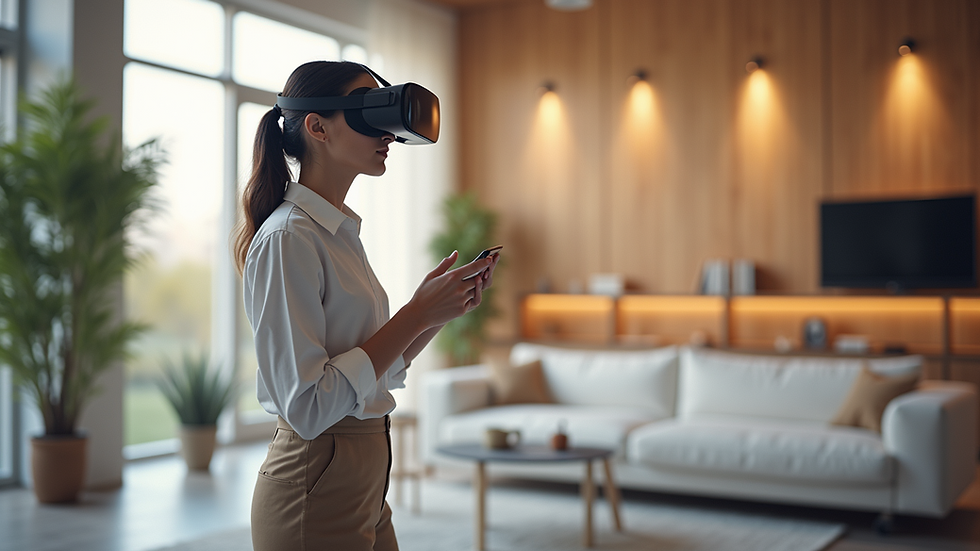Choosing Between Still Renders, 360° Walkthroughs & VR: What’s Right for You?
- Neoscape Dimensions
- Oct 23
- 4 min read
Choosing the right visualization method for your project can feel overwhelming given the numerous options available today. Whether you are an architect, a real estate agent, or a designer, how you present your ideas can greatly influence their reception. In this post, we will explore three popular visualization methods: still renders, 360° walkthroughs, and virtual reality (VR). Each method offers unique advantages suited for different applications. By understanding these methods, you can make an informed choice that aligns with your project goals.
Understanding Still Renders
Still renders are high-quality, static images that effectively showcase a design or concept. Typically used in architectural visualization, product design, and marketing materials, these renders provide clear and detailed representations, making them visually appealing.
Examples of effective use of still renders include:
Marketing Materials: A well-executed still render can boost interest, as seen in real estate brochures where properties are showcased with stunning visuals. Properties with high-quality images can attract up to 50% more inquiries.
Presentations: During client meetings, a compelling still render can clarify a design idea. For instance, an architect presenting plans for a new building can use still renders to illustrate textures and lighting.
Portfolio Development: For designers and architects, still renders form a critical part of their portfolio, often showcasing unique skills and creativity. A strong portfolio can lead to a 30% increase in client projects.
While still renders are visually striking, they provide a snapshot in time and lack the interactive element some clients desire, limiting exploration of the space.
The Appeal of 360° Walkthroughs
360° walkthroughs create a more immersive experience than still renders. These interactive visualizations allow users to navigate through a space, offering a sense of scale and depth that static images cannot. Users control their viewpoint, exploring different angles at their own speed.
The benefits of 360° walkthroughs include:
Interactivity: Users engage with the space and understand layouts more effectively. For instance, in real estate, clients can better assess property dimensions and room layouts, increasing likelihood of purchase by 20%.
Realism: The ability to move through a space generates a more realistic experience. This is particularly useful for clients in markets like tourism, where virtual tours can boost engagement.
Versatility: Businesses use 360° walkthroughs in diverse contexts, from real estate listings to virtual museum tours, which can attract thousands of visitors interested in remote explorations.
However, creating 360° walkthroughs often requires more technical expertise and may not offer the same level of visual detail found in still renders. This complexity might challenge some audiences' ability to navigate effectively.
Exploring Virtual Reality (VR)
Virtual reality immerses users in a fully interactive 3D environment. With VR headsets, individuals experience a space as if they were physically present, leading to an engaging experience. This method has gained popularity in industries such as real estate, architecture, and gaming.
Key advantages of VR include:
Full Immersion: Users feel present within a space, enhancing emotional connection and understanding of the design. In fact, studies show that 70% of participants feel more connected to a design experienced in VR compared to static images.
Enhanced Engagement: The dynamic nature of VR can captivate users. For example, during presentations, incorporating VR can keep clients more engaged and lead to higher satisfaction levels.
Real-Time Feedback: Designers can make immediate adjustments based on user interactions. This capability encourages creative brainstorming and can streamline development processes.
Despite these benefits, VR presents challenges such as the need for specialized equipment and software, which can be limiting. Additionally, not all clients may be comfortable using VR technology, impacting accessibility.
Choosing the Right Method for Your Project
When choosing between still renders, 360° walkthroughs, and VR, consider these factors:
Target Audience: Knowing your audience is critical. For instance, tech-savvy clients might enjoy the immersion of VR, while others may prefer the straightforwardness of still renders.
Project Goals: Define what you want to accomplish. For stunning marketing pieces, still renders may shine. For interactive experiences, 360° walkthroughs or VR are the way to go.
Budget and Resources: Each method has its cost and resource requirements. Determine what fits within your budget and assess the technical skillset of your team.
Time Constraints: Consider your project timeline. Generally, still renders can be created faster than 360° walkthroughs or VR experiences, which often require additional development time.
Design Complexity: If you have a detailed design, still renders might be more effective. For larger spaces or projects that need exploration, 360° walkthroughs or VR can be ideal.
The Future of Visualization
With technology progressing rapidly, visualization methods will undoubtedly evolve. Advancements in rendering software, VR technology, and interactive design will open up new avenues for presenting ideas and concepts. Staying updated on these trends can help you select the best visualization method for your future projects.

Making the Right Choice
Ultimately, the decision between still renders, 360° walkthroughs, and VR depends on your specific needs and goals. Each method has its strengths and weaknesses.
Still renders excel in high-quality representation, 360° walkthroughs offer interactivity, and VR delivers a fully immersive experience. By considering your target audience, project objectives, budget, and design complexity, you can confidently select the visualization method that aligns with your vision.
As visualization continues to advance, embracing new technologies will allow you to effectively communicate your ideas. Whichever method you choose, the right visualization can elevate your project and transform how your audience engages with your work.




Comments